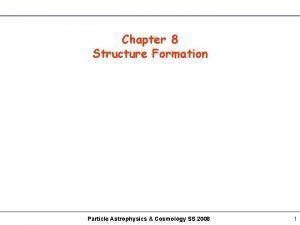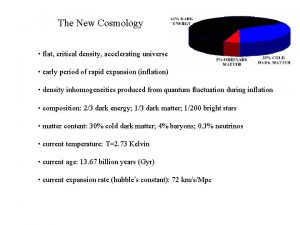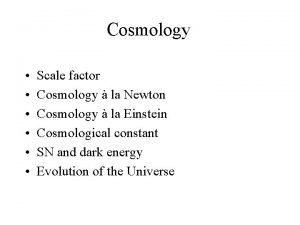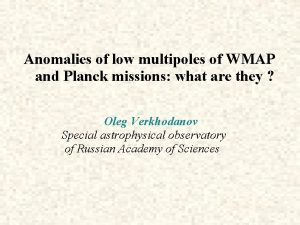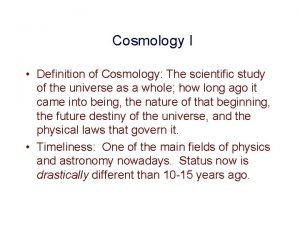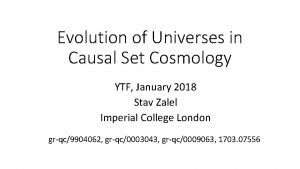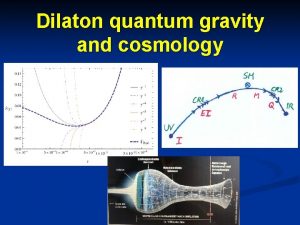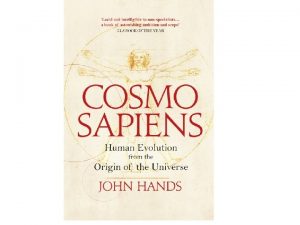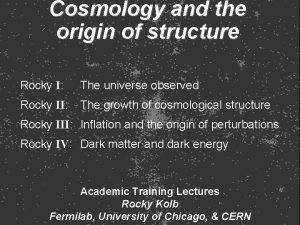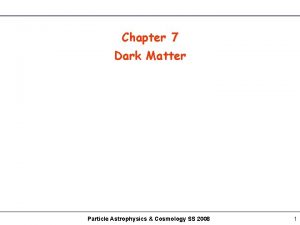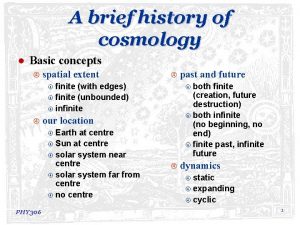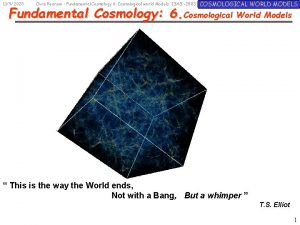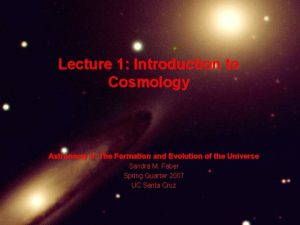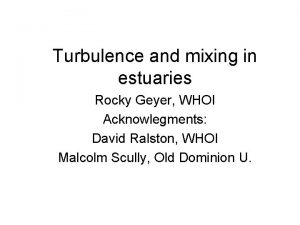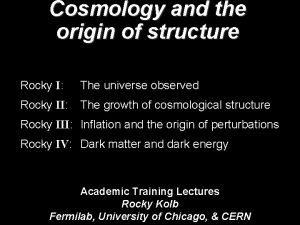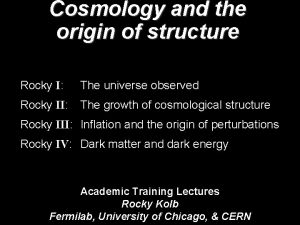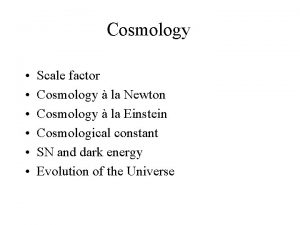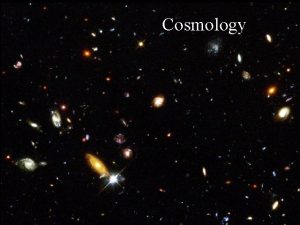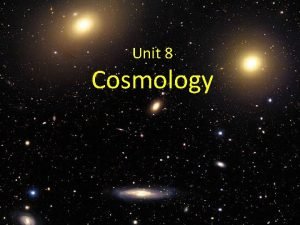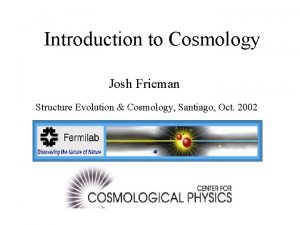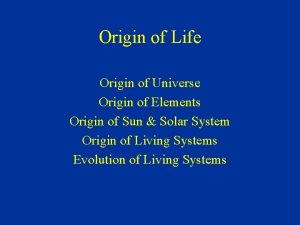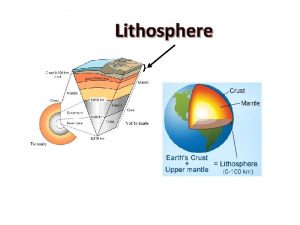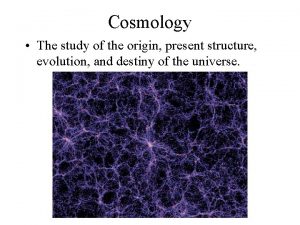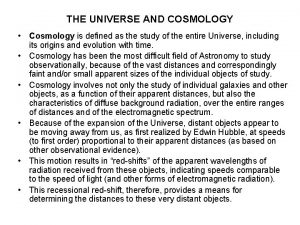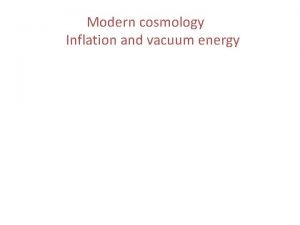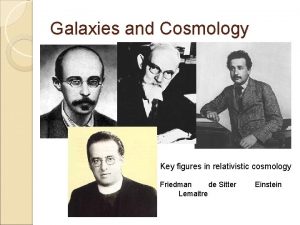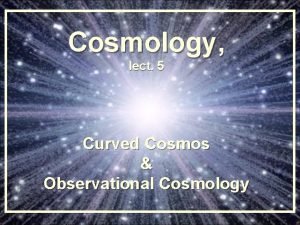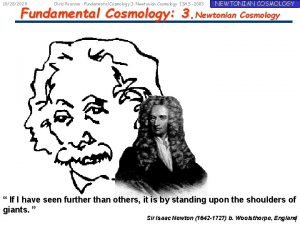Cosmology and the origin of structure Rocky I



























































- Slides: 59

Cosmology and the origin of structure Rocky I: The universe observed Rocky II: The growth of cosmological structure Rocky III: Inflation and the origin of perturbations Rocky IV: Dark matter and dark energy Academic Training Lectures Rocky Kolb Fermilab, University of Chicago, & CERN

origin of small initial perturbations tim e nature of the damn little black dots Seeds of structure

Missing Pieces Dark Matter

NGC 253 in Sculptor

R v R

v (km/s) observed 100 expected from luminous disk 50 5 10 R (kpc) M 33 rotation curve

Rotation curves CO – central regions Optical – disks HI – outer disk & halo Sofue & Rubin




Tony Tyson, Lucent


The evolved spectrum

Most of the universe is ! • Modified Newtonian dynamics • Planets • Mass disadvantaged stars brown • Black holes red white gravitational microlensing

Large Magellanic Cloud 150, 000 light years distant 100 million stars

brown dwarf LMC observer



Microlensing black-hole candidates Bennett et al. (also Mao et al. )

Stellar-Mass Black Holes in the ‘hood In the Solar Neighborhood (with Jim Chisholm & Scott Dodelson)

Model spectral energy distributions: spectral energy distribution (contribution per decade) RASS SDSS

Sloan: a 2. 5 m telescope & instruments to 1. image the sky to 23 rd mag in 5 colors ( objects) 2. take the spectra of objects (mostly extragalactic) New Mexico State Japan Germany


SDSS 2. 5 m telescope data acquisition system


SDSS camera

Color-color space stars in color-color space

Color-color cut + RASS detection SDSS Early Data Release = 3. 7 million objects SDSS color cut = 150, 000

RASS ROSAT All-Sky Survey. . ROSAT Rontgen Satellite X-Ray Observatory Germany/US/UK 1990 -1999

ROSAT effective area

Color-color cut + RASS detection SDSS Early Data Release = 3. 7 million objects SDSS color cut = 150, 000 SDSS + RASS = 47 47 is a manageable number (can examine each individually) 7 targeted for spectroscopy by SDSS (5 stars + 2 QSOs) Can define measure of how far from stellar locus in 4 color-color spaces



Most of the universe is ! • Modified Newtonian dynamics • Planets • Mass disadvantaged stars brown red white • Black holes • The weight of space gravitational microlensing

Most of the universe is ! • Modified Newtonian dynamics • Planets • Mass disadvantaged stars brown red white gravitational microlensing • Black holes • The weight of space • Fossil remnant of the big bang

Neutrinos? • Neutrinos are known to exist three active + sterile? • Neutrinos are strongly suspected to have mass • Massive neutrinos contribute to the mass density

The evolved spectrum



Relative abundance Cold thermal relics actual freeze out equilibrium MX /T (independent of mass)

Cold thermal relics X q q q X X Goodman & Witten

http: //dmtools. berkeley. edu (Gaitskell/Mandic) DAMA CDMS Edelweiss models

CMSSM Ellis, Olive, Santoso

Ellis, Olive, Santoso

Ellis, Olive, Santoso

Thermal WIMP: interaction & mass limit Thermal WIMP: Interaction strength determined Mass undetermined (but < 200 Te. V)

Freeze out equilibrium n. X /s Relative abundance Nonthermal relics actual MX /T at freezeout

Expanding universe particle creation (Arnowit, Birrell, Bunch, Davies, Deser, Ford, Fulling, Grib, Hu, Kofman, Mostepanenko, Page, Parker, Starobinski, Unruh, Vilenkin, Wald, Zel’dovich, …) first application: density perturbations from inflation gravitational waves from inflation (Guth & Pi; Starobinski; Bardeen, Steinhardt, & Turner; Hawking; Rubakov; Fabbi & Pollack; Allen) new application: dark matter (Chung, Kolb, & Riotto; Kuzmin & Tkachev) • require (super)massive particle “X” • stable (or at least long lived) • initial inflationary era followed by radiation/matter

WIMPZILLA production Chung, Kolb, Riotto (also Kuzmin & Tkachev) chaotic inflation

WIMPZILLA production Chung, Kolb, Riotto (also Kuzmin & Tkachev) chaotic inflation

Superheavy particles Inflaton mass (in principle measurable from gravitational wave background, guess ) may signal a new mass scale in nature. Other particles may exist with mass comparable to the inflaton mass.

Superheavy relic (wimpzilla) characteristics: • Supermassive: 109 - 1019 Ge. V (~ 1012 Ge. V ? ) • abundance may depend only on mass • abundance may be independent of interactions – sterile? – electrically charged? – strong interactions? – weak interactions? • unstable (lifetime > age of the universe)?

WIMPZILLA footprints: Decay: Ultra High Energy Cosmic Rays Annihilate: Galactic Center, Sun Isocurvature Perturbations: Structure Formation, CMB Direct Detection: Bulk, Underground Searches

Dark Matter WIMP or WIMPZILLA

www-phys. llnl. gov/N_Div/Axion/axion. html

Particle Dark Matter Candidates • neutrinos • sterile neutrinos, gravitinos • LSP (neutralino, sneutrino, …) (hot dark matter) (warm dark matter) (cold dark matter) • axion, axion clusters • WIMPZILLA • solitons (B-balls; Q-balls; Odd-balls, …. )

• Origin of structure: a complex natural phenon • Gravitational instability of perturbations from inflation: a simple, elegant, compelling explanation “For every complex natural phenomenon there is a simple, elegant, compelling, wrong explanation. ” - Tommy Gold

What We “Know” * The matter density is dominated by cold dark matter , which we know nothing about! The perturbations arise from inflationary dynamics, which depends on particle physics at high energies , which we know nothing about! The universe is dominated by a cosmological term (dark energy, funny energy, quintessence, polenta, cosmological constant, cosmoillogical constant, …. ) , which we know less than nothing about! *It ain’t what you don’t know, it’s what you know that ain’t so!

Cosmology and the origin of structure Rocky I: The observed universe Rocky II: The growth of cosmological structure Rocky III: Inflation and the origin of perturbations Rocky IV: Dark matter and dark energy Academic Training Lectures Rocky Kolb Fermilab, University of Chicago, & CERN
 Cosmology
Cosmology Critical density
Critical density Scale factor cosmology
Scale factor cosmology Multipole expansion
Multipole expansion Definition of cosmology
Definition of cosmology Cosmology
Cosmology Crossover cosmology
Crossover cosmology Concordance model of cosmology
Concordance model of cosmology Cosmology
Cosmology Cosmology
Cosmology Newton cosmology
Newton cosmology Cosmology
Cosmology Intro to cosmology
Intro to cosmology Jain cosmology
Jain cosmology Which colonial region contained rocky soil and cold climate
Which colonial region contained rocky soil and cold climate Rocky bay child and family services
Rocky bay child and family services A section of the nile river with rapids and rocky terrain
A section of the nile river with rapids and rocky terrain Hát kết hợp bộ gõ cơ thể
Hát kết hợp bộ gõ cơ thể Slidetodoc
Slidetodoc Bổ thể
Bổ thể Tỉ lệ cơ thể trẻ em
Tỉ lệ cơ thể trẻ em Gấu đi như thế nào
Gấu đi như thế nào Chụp tư thế worms-breton
Chụp tư thế worms-breton Hát lên người ơi
Hát lên người ơi Kể tên các môn thể thao
Kể tên các môn thể thao Thế nào là hệ số cao nhất
Thế nào là hệ số cao nhất Các châu lục và đại dương trên thế giới
Các châu lục và đại dương trên thế giới Công thức tiính động năng
Công thức tiính động năng Trời xanh đây là của chúng ta thể thơ
Trời xanh đây là của chúng ta thể thơ Mật thư tọa độ 5x5
Mật thư tọa độ 5x5 Làm thế nào để 102-1=99
Làm thế nào để 102-1=99 độ dài liên kết
độ dài liên kết Các châu lục và đại dương trên thế giới
Các châu lục và đại dương trên thế giới Thơ thất ngôn tứ tuyệt đường luật
Thơ thất ngôn tứ tuyệt đường luật Quá trình desamine hóa có thể tạo ra
Quá trình desamine hóa có thể tạo ra Một số thể thơ truyền thống
Một số thể thơ truyền thống Cái miệng nó xinh thế chỉ nói điều hay thôi
Cái miệng nó xinh thế chỉ nói điều hay thôi Vẽ hình chiếu vuông góc của vật thể sau
Vẽ hình chiếu vuông góc của vật thể sau Nguyên nhân của sự mỏi cơ sinh 8
Nguyên nhân của sự mỏi cơ sinh 8 đặc điểm cơ thể của người tối cổ
đặc điểm cơ thể của người tối cổ Ví dụ giọng cùng tên
Ví dụ giọng cùng tên Vẽ hình chiếu đứng bằng cạnh của vật thể
Vẽ hình chiếu đứng bằng cạnh của vật thể Fecboak
Fecboak Thẻ vin
Thẻ vin đại từ thay thế
đại từ thay thế điện thế nghỉ
điện thế nghỉ Tư thế ngồi viết
Tư thế ngồi viết Diễn thế sinh thái là
Diễn thế sinh thái là Các loại đột biến cấu trúc nhiễm sắc thể
Các loại đột biến cấu trúc nhiễm sắc thể Các số nguyên tố
Các số nguyên tố Tư thế ngồi viết
Tư thế ngồi viết Lời thề hippocrates
Lời thề hippocrates Thiếu nhi thế giới liên hoan
Thiếu nhi thế giới liên hoan ưu thế lai là gì
ưu thế lai là gì Khi nào hổ con có thể sống độc lập
Khi nào hổ con có thể sống độc lập Khi nào hổ con có thể sống độc lập
Khi nào hổ con có thể sống độc lập Sơ đồ cơ thể người
Sơ đồ cơ thể người Từ ngữ thể hiện lòng nhân hậu
Từ ngữ thể hiện lòng nhân hậu Thế nào là mạng điện lắp đặt kiểu nổi
Thế nào là mạng điện lắp đặt kiểu nổi Rocky geyer
Rocky geyer
